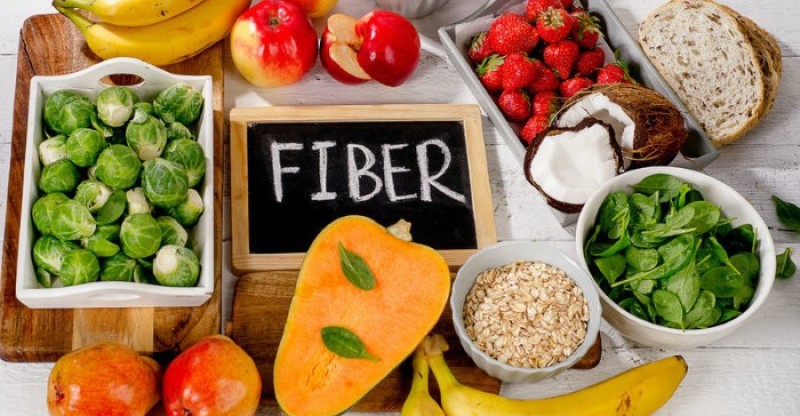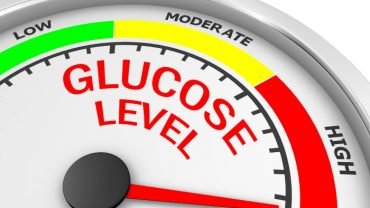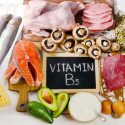25 High-Fiber Foods You Should Try
Fiber is something we all need, but do not necessarily get enough of.
In fact, studies show that most Americans only get an average of about 15-17 grams of fiber each day.(1)
However, men really need 38 grams, and women need 25 grams.
We need dietary fiber to help keep our bowel movements regular.
Prebiotic fiber feeds the probiotics that line our digestive systems, causing healthy gut flora to flourish.
Dietary fiber doesn’t get digested, but it is used to help keep the digestive and immune systems healthy.
So which foods have fiber that can help us reach our recommended daily intake?
Avocados
Avocados are one of the best sources of fiber.(2)
They are loaded with healthy fats (rather than carbohydrates) and contain about 6.7% (or 10 grams) per cup.
Avocados are also rich in vitamins C, K, E, B5, B6, folate, and potassium.
Avocados are low in saturated fats and do not contain sodium or cholesterol.
Therefore, they are a safe superfood for people with high cholesterol or sodium levels.
Strawberries
Strawberries are fantastic sources of vitamin C and powerful antioxidants, which help keep free radicals from causing damage to your bodily tissues.(2)
They also provide a good amount of fiber.
In one cup of strawberries, you get around 3 grams of fiber.
You can eat them on their own, dip them in some yummy dark chocolate (which you’ll find further down on this list), or mix them into a fruit salad with other high-fiber fruits on the list.
Raspberries
Raspberries are another popular fruit that’s high in fiber.(3)
One single cup contains about 8 grams of fiber, which equals 6.5%.
In addition to being loaded with fiber, raspberries also contain 43% of needed vitamin C and 41% of needed manganese.
They’re also being studied for their ability to increase metabolism.
If you buy fully ripened raspberries, you will get a maximized amount of antioxidants.
Pears
With a much gentler taste than raspberries, pears are one of the best sources of fiber, since a medium-sized pear contains about 5.5 grams.(4)
They’re also rich in vitamins C and K and copper.
Additionally, pears contain flavonoids that might improve insulin sensitivity in anyone with Type 2 diabetes.
Bananas
The average banana contains just over 3 grams of fiber and is densely packed with vitamins B6, C, manganese, and potassium.(5)
Bananas have water-soluble pectins, which help regulate the digestion of carbs and moderate blood sugar.
An unripe (green) banana contains resistant starch, which is similar to fiber but is actually an undigested carb.
Apples
You’ve surely heard that apples keep the doctor away, but they’re not high in fiber.(6)
However, they do change bacteria in the digestive tract, particularly in the large intestine.
Apples that are eaten in their whole-food form give the most fiber-related benefits.
Broccoli
Many of us grew up hating broccoli.
But by not eating it, you are missing out on a lot of nutritional value.
This extremely dense, cruciferous veggie packs about 2.4 grams of fiber per cup, and it is loaded with B vitamins, folate, vitamin C, vitamin K, iron, potassium, and manganese.(7)
Additionally, it is rich in cancer-fighting nutrients, antioxidants, and protein.
Beets
Beets are becoming somewhat more popular than they used to be.
Many people don’t know that they are full of the phytonutrient betalain, antioxidants, and anti-inflammatory agents (which aid in bodily detoxification).(8)
They’re also rich in folate, manganese, and potassium.
One cup of beets contains 3.8 grams of fiber.
Carrots
This crunchy root pairs a low-calorie count with a high fiber count (3.4 grams per cup).
Carrots also contain other essential vitamins and nutrients, including beta-carotenes (antioxidants that get converted into vitamin A), vitamin K, vitamin B6, biotin, and magnesium.(9)
If you’re munching on one of the orange variety, a recommended daily intake is at least a half-cup per day.
Brussels Sprouts
Ever whine as a kid when your mother told you to eat your Brussels sprouts?
If so, you’re not alone, but your mother had a good reason for telling you to do so.
Like broccoli, Brussels sprouts are cruciferous vegetables that are loaded with fiber (3.3 grams per cup, to be exact).(10)
Also, like broccoli, they’re packed with powerful cancer-fighting agents.
Artichokes
Artichokes aren’t exactly the most popular vegetable out there, but perhaps they should be.
Each artichoke contains 6.9 grams of fiber, making them one of the best high-fiber foods on the market.(11)
Kidney Beans
Kidney beans are another one of the best sources of fiber.
Just one cup of cooked beans contains about 11.3 grams of fiber.(12)
As a legume, kidney beans are rich in protein.
They also contain 295% molybdenum, a key nutrient that balances sulfur levels.
And they have powerful antioxidants and play a role in the nervous system’s metabolism of the neurotransmitters norepinephrine, serotonin, melatonin, and epinephrine.
Lentils
Are you on a budget?
Lentils are a great way to save money, and they’re one of the best high-fiber foods out there.
Like kidney beans, they contain a very high level of molybdenum.
A single cup of cooked lentils contains a whopping 15.6 grams of fiber.(13)
Lentils contain both soluble and insoluble dietary fiber.
They’re also high in folate, copper, phosphorus, manganese, and iron.
Split Peas
Split peas are another one of the best sources of fiber.
One cup of cooked split peas contains about 16.3 grams of fiber.(14)
They can be made into soups, and are very high in protein and low in fat.
Chickpeas
Chickpeas (also referred to as garbanzo beans) are becoming quite popular throughout the world.
In fact, a recent study showed that participants who eat chickpeas are less likely to indulge in unhealthy snack foods and feel more satisfied with their diets.
A cup of cooked chickpeas contains about 12.5 grams of fiber, which is 50% of the Daily Value (DV).(15)
Also, the insoluble fiber found in chickpeas supports colon-cell health and reduces the risk for colon cancer.
Quinoa
You might not know how to pronounce this word (it’s “keen-wah”), but you should know that it is a high-fiber food.
There are 1.6 grams of fiber in a cup of cooked quinoa, and it is an antioxidant, has more heart-healthy fats than wheat and other cereal ingredients, and is rich in magnesium, manganese, and copper.(16)
No wonder the Food and Agricultural Organization of the United Nations (FAO) deemed 2013 “The International Year of the Quinoa”!
Popcorn
Are you surprised to see popcorn on this list?
Popcorn isn’t known for being a healthy snack, which it isn’t when you load it with fats.
Fats drastically impact the fiber/calorie ratio. However, air-popped popcorn is quite high in fiber.
In fact, popcorn contains 14.5 grams of fiber per 100 grams.(17)
If you lay off the butter and salt, popcorn can actually be a decent snack for those looking to up their fiber intake.
Oats
If you are looking for an extremely healthy grain to add into your diet, the best source of fiber from a grain can be found in oats.
If you’re consuming raw oats, you will get 16.5 grams of fiber in just one cup.(18)
They are also extremely high in manganese, molybdenum, copper, biotin, and vitamin B1.
And they have been shown to lower cholesterol levels, and have antioxidants in them that can help reduce the risk of developing cardiovascular disease.
Additionally, oats might aid in the immune system’s response to infections, stabilize blood sugar levels in people with Type 2 diabetes, and protect against both breast cancer and childhood asthma.
Also, oats are a great wheat alternative for anyone with Celiac’s disease, despite the fact that they contain trace amounts of gluten.
Almonds
If you are looking for a healthy snack, pick up some almonds.
They are extremely high in fiber, containing 3.5 grams per ounce.(19)
Almonds are a type of tree nut that is high in biotin, vitamin E, manganese, copper, B2, and other important vitamins and minerals.
Researchers have found that almonds help lower cholesterol levels and protect the body against diabetes and cardiovascular disease.
They can also help improve blood fats, aid in weight loss, and reduce the risk of weight gain.
Dark Chocolate
Looking for an excuse to satisfy your sweet tooth?
How about allowing yourself a little bit of dark chocolate as a way to get your daily value of fiber?
In a one-ounce piece of dark chocolate, there are about 3.1 grams of fiber.(20)
Dark chocolate is also high in copper, manganese, magnesium, and iron.
And it is packed with antioxidants, might help lower blood pressure, improves blood flow throughout the body, and is great for your skin!
Sweet Potatoes
Another high-fiber superfood that’s rapidly gaining popularity is sweet potatoes.
If you peel and boil one medium-sized sweet potato, you will get about 3.8 grams of fiber.(21)
They are also a great source of beta-carotene, vitamin A, vitamin C, manganese, and B vitamins.
Sweet potatoes have been shown to have powerful antioxidants and anti-inflammatory properties, improve blood-sugar regulation in the body, and might have some antifungal and antibacterial properties.
However, more studies are needed to clarify how those properties work.
Chia Seeds
Chia seeds pack 10 grams of fiber in every ounce, are rich in manganese and phosphorus, and contain healthy essential fatty acids.
As a powerful antioxidant, they are known to help keep the skin from aging, support the growth of probiotics in the gut, help with treating diabetes and boost the body’s energy levels and metabolic rate.(22)
They can be added to oats to make a delicious breakfast or can be made into a delicious pudding.
Common Fig
An average-sized fig contains 1.5 grams of fiber.(23)
They’re known to be one of the world’s healthiest foods, yet they are not as commonly consumed as one might expect.
In addition to their high fiber content, the common fig is rich in vitamin B6, copper, manganese, and potassium.
They’re great for lowering blood pressure and are a sweet alternative for anyone looking to lose weight.
Acorn Squash
Acorn squash (also known as pepper squash) is a delicious winter squash that packs 2.1 grams of fiber into just one cup.(24)
Acorn squash is also high in antioxidants and carotenoids, and it is known to elevate the immune system and decrease inflammation throughout the body.
Okra
Last but certainly not least — okra.
Even if you haven’t heard of it, you should consider trying it.
A single cup of okra contains 3.2 grams of dietary fiber.(25)
It is also loaded with folate, vitamin C, and antioxidants.
It is known to benefit anyone with diabetes and is very tasty when sauteed with tomatoes and garlic.
Conclusion
Now you know which foods have fiber and can add these to your daily intake.
Remember to slowly increase your portions and stay hydrated as you consume more fiber.
Those who follow whole-food diets will have an easier time meeting (or even exceeding) their daily value, but it is important to remember that there is no such thing as overdosing on fiber.
FDA Compliance
The information on this website has not been evaluated by the Food & Drug Administration or any other medical body. We do not aim to diagnose, treat, cure or prevent any illness or disease. Information is shared for educational purposes only. You must consult your doctor before acting on any content on this website, especially if you are pregnant, nursing, taking medication, or have a medical condition.
HOW WOULD YOU RATE THIS ARTICLE?






